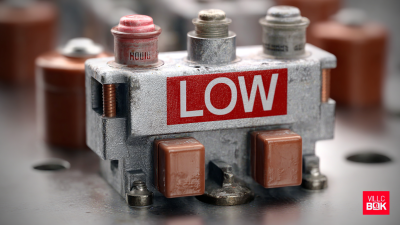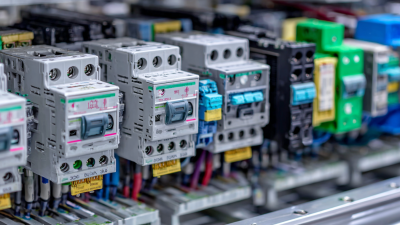
Understanding the Importance of Acb Circuit Breakers in Modern Electrical Systems
In the realm of modern electrical systems, the role of the ACB Circuit Breaker is paramount, serving as a crucial component for safeguarding electrical infrastructures. According to a recent report by MarketsandMarkets, the global circuit breaker market is projected to reach $12 billion by 2025, with ACB Circuit Breakers witnessing substantial growth due to their reliability and efficiency in high-voltage applications.
 These devices not only protect against overloads and short circuits, but also enhance the operational integrity of electrical systems by offering advanced features such as automatic resetting and remote operation. As industries increasingly emphasize safety and operational efficiency, understanding the importance of ACB Circuit Breakers becomes essential for engineers and facility managers alike, ensuring compliance with electrical standards and reducing the risk of costly outages.
These devices not only protect against overloads and short circuits, but also enhance the operational integrity of electrical systems by offering advanced features such as automatic resetting and remote operation. As industries increasingly emphasize safety and operational efficiency, understanding the importance of ACB Circuit Breakers becomes essential for engineers and facility managers alike, ensuring compliance with electrical standards and reducing the risk of costly outages.
The Role of ACB Circuit Breakers in Enhancing System Reliability
ACB circuit breakers play a critical role in modern electrical systems, significantly enhancing their reliability. These devices are designed to protect electrical circuits from overloads and short circuits, ensuring that power systems operate smoothly without interruptions. By automatically disconnecting power in the event of a fault, ACB circuit breakers prevent damage to electrical equipment and minimize the risk of electrical fires, thereby providing a safer environment for both residential and industrial applications.

In addition to safeguarding equipment, the implementation of ACB circuit breakers contributes to the overall efficiency of electrical systems. Their ability to handle high levels of current makes them particularly suitable for heavy-duty applications, such as in infrastructure development, where reliability and performance are paramount. As industries evolve and adopt increasingly complex electrical solutions, the role of ACB circuit breakers becomes even more essential, ensuring that systems remain resilient in the face of challenges and facilitating the transition towards smarter, more integrated electrical grids.
Key Features of Modern ACB Circuit Breakers for Efficient Performance
Low Voltage Air Circuit Breakers (ACBs) are vital components in modern electrical systems, designed to handle substantial current loads while ensuring safety and reliability. The key features of contemporary ACBs include advanced protection mechanisms, compact designs, and interoperability with smart grid technology. According to recent industry reports, the global ACB market is expected to grow significantly, reflecting the increasing demand for energy-efficient solutions within both commercial and industrial applications. These circuit breakers can integrate seamlessly into existing systems, providing features like automatic fault detection and remote monitoring to enhance operational efficiency.
The efficiency of ACBs is further attributed to their ability to minimize downtime and reduce maintenance costs. With features such as an adjustable trip setting and various modes of operation, these modern breakers adapt to diverse electrical environments. Furthermore, the incorporation of digital technology allows for real-time data monitoring, enabling proactive maintenance strategies. The market analysis shows that ACBs not only provide critical safety functions but also contribute to energy savings, with up to 20% reduction in power losses compared to traditional solutions. This combination of efficiency and smart technology positions ACBs as essential components in the evolving landscape of electrical infrastructure.
Best Practices for Installing ACB Circuit Breakers in Electrical Systems
ACB (Air Circuit Breakers) play a pivotal role in modern electrical systems, ensuring safety and reliability. When installing ACBs, it is crucial to adhere to best practices to maximize their efficacy. Proper selection of the circuit breaker based on system requirements—considering factors such as voltage, type, and installation environment—can significantly impact performance. For instance, understanding whether to use indoor or outdoor models, as well as the appropriate voltage ratings, helps in accommodating the specific demands of electrical networks.
Attention to detail during installation also enhances the lifespan and functionality of ACBs. It is essential to conduct thorough site assessments, ensuring that the electrical infrastructure is compatible with the ACB specifications. Regular maintenance practices, including testing functionality and inspecting connections, are vital for preventing faults and ensuring optimal operation. By following these best practices, installed ACBs can effectively safeguard electrical systems against overloads and short circuits, ultimately contributing to operational efficiency and safety in modern settings.
Importance of ACB Circuit Breakers in Modern Electrical Systems
Common Issues with ACB Circuit Breakers and How to Troubleshoot Them
Air Circuit Breakers (ACBs) are vital components in modern electrical systems, offering protection and control for electrical circuits. However, they can encounter several common issues that may compromise their performance. One of the frequent problems is improper settings, which can lead to nuisance tripping or failure to trip during faults. It is essential to periodically review and adjust the settings according to the load requirements and manufacturer specifications to ensure optimal operation.
Another common issue with ACBs is wear and tear of their contacts, which can lead to inadequate connectivity and overheating. Regular maintenance, including visual inspections and testing, can help identify signs of wear early on. Additionally, improper installation or environmental factors such as humidity and dust accumulation can also affect their reliability. Troubleshooting these concerns involves checking for alignment and securing connections, as well as ensuring that the circuit breaker is clean and well-maintained to uphold its integrity and functionality.
Understanding the Importance of ACB Circuit Breakers in Modern Electrical Systems - Common Issues with ACB Circuit Breakers and How to Troubleshoot Them
| Issue | Description | Possible Causes | Troubleshooting Steps |
|---|---|---|---|
| Frequent Tripping | ACB trips unexpectedly during normal operation. | Overload, short circuit, or internal fault. | Check load conditions, inspect for short circuits, and test the integrity of the circuit. |
| Failure to Reset | ACB does not reset after tripping. | Mechanical failure or internal damage. | Examine the mechanism and electrical components, and replace damaged parts. |
| Temperature Rise | Circuit breaker becomes excessively hot during operation. | Poor connections or overload condition. | Inspect connections for tightness and overheating signs, and reduce load if necessary. |
| Noise During Operation | Unusual sounds coming from the ACB. | Loose components or internal wear. | Check for loose screws and ensure all parts are secure; consider professional assessment. |
| Indicator Lights Failure | Status lights fail to indicate operation status. | Burnt-out bulbs or faulty circuitry. | Inspect and replace bulbs, and check wiring for faults. |
Understanding the Cost-Effectiveness of ACB Circuit Breakers in Long-Term Usage
Air Circuit Breakers (ACBs) are essential components in modern electrical systems, particularly due to their cost-effectiveness in long-term usage. With a projected market growth from $3.2 billion in 2023 to $4.1 billion by 2028, ACBs are gaining traction among industries that prioritize reliable and efficient electrical solutions. Their fundamental role is to prevent overloads and short circuits, ensuring the safety and performance of electrical networks. As the demand for efficient energy management increases, ACBs become a financially viable choice for both new installations and upgrades to existing systems.

The longevity and durability of ACBs further contribute to their cost-effectiveness. Designed to withstand harsh conditions and extensive use, these breakers minimize the need for frequent replacements and maintenance. As the air circuit breaker market anticipates reaching $9.4 billion by 2035, the sustained investment in ACB technology indicates a strong belief in their potential to provide significant savings over time. This aspect is crucial for businesses aiming to maintain operational efficiency while managing costs in an increasingly competitive environment.
Related Posts
-

Ultimate Guide to Selecting the Right Air Circuit Breaker for Your Industrial Needs
-

7 Must-Know Tips to Maximize Efficiency with Air Breaker Circuit Breakers in Your Facility
-

Top 10 Electronic Circuit Breaker Manufacturers from China at the 137th Canton Fair
-

Exploring Unique Alternatives to the Best Low Voltage Circuit Breaker for Your Electrical Needs
-

Understanding the Advantages of Using Electronic Circuit Breakers in Modern Electrical Systems
-

How to Choose the Right MCCB Adjustable for Your Electrical Needs

 JCB1-125
JCB1-125 JCB2-40M
JCB2-40M JCB3-63DC
JCB3-63DC JCB3-80H
JCB3-80H JCB3-80M
JCB3-80M JCBH-125
JCBH-125 JC125-4P
JC125-4P JCMX
JCMX JCSD
JCSD JCOF
JCOF JCMX1-125
JCMX1-125 JCOF1-125
JCOF1-125 JCSD1-125
JCSD1-125 JCR3HM
JCR3HM JCRD2-125
JCRD2-125 JCRD4-125
JCRD4-125 JCRB2-100
JCRB2-100 JC3RH-2P
JC3RH-2P JC3RH-S
JC3RH-S JC3RH-B
JC3RH-B JC3RH-BS
JC3RH-BS JCR2-63
JCR2-63 JCR1-40
JCR1-40 JCB2LE-80M
JCB2LE-80M JCB2LE-80M
JCB2LE-80M JCB2LE-80M
JCB2LE-80M JCB2LE-40M
JCB2LE-40M JCB1LE-125
JCB1LE-125 JCB3LM-80
JCB3LM-80 JCH2-125
JCH2-125 JCH2-125
JCH2-125 CJX2
CJX2 CJ19
CJ19 JCMCU
JCMCU JCHA
JCHA JCSD-40
JCSD-40 JCSD-60
JCSD-60 JCSP-40
JCSP-40 JCSP-60
JCSP-60 JCSPV
JCSPV WEW1-1000
WEW1-1000 WEW1-1600
WEW1-1600 WEW1-2000
WEW1-2000 WEW1-3200
WEW1-3200 WEW1-4000
WEW1-4000 WEW1-6300
WEW1-6300 DC6-125
DC6-125 AX-400-1250
AX-400-1250 AXAL-400-1250A
AXAL-400-1250A AL-400-1250
AL-400-1250 DC3-160
DC3-160 AXS-400-1250A
AXS-400-1250A SHT-125-160
SHT-125-160 UVT-125-160A
UVT-125-160A P-250A-3P-A
P-250A-3P-A 400-3P/4P terminal cover
400-3P/4P terminal cover 1250-3Pmccb accessories busbar
1250-3Pmccb accessories busbar 250-3P terminal conver
250-3P terminal conver WLM6-TCV-160A-3P
WLM6-TCV-160A-3P WLM6-MIP-250A
WLM6-MIP-250A WLM6-125A-3300 3P/4P
WLM6-125A-3300 3P/4P WLM6-160A-3300 3P/4P
WLM6-160A-3300 3P/4P WLM6-250A-3300 3P/4P
WLM6-250A-3300 3P/4P WLM6-400A-3300 3P/4P
WLM6-400A-3300 3P/4P WLM6-630A-3300 3P/4P
WLM6-630A-3300 3P/4P WLM6-800A-3300 3P/4P
WLM6-800A-3300 3P/4P WLM6-1250A-3300 3P/4P
WLM6-1250A-3300 3P/4P WLM6-1600A-3300 3P/4P
WLM6-1600A-3300 3P/4P WLM6-2000A 3P/4P
WLM6-2000A 3P/4P WLM8-125H-3300
WLM8-125H-3300 WLM8-250H-3300
WLM8-250H-3300 WLM8-400H-3300
WLM8-400H-3300 WLM8-400H-4300
WLM8-400H-4300 WLM8-630H-3300
WLM8-630H-3300 WLM8-630H-4300
WLM8-630H-4300 WLM6RT-125A
WLM6RT-125A WLM6RT-160A
WLM6RT-160A WLM6RT-250A
WLM6RT-250A WLM6RT-400A
WLM6RT-400A WLM6RT-630A
WLM6RT-630A WLM6RT-800A
WLM6RT-800A WLM6RT-1250A
WLM6RT-1250A WLM6E-160A-3300 3P
WLM6E-160A-3300 3P WLM6E-250A-3300
WLM6E-250A-3300 WLM6E-400A-3300 3P/4P
WLM6E-400A-3300 3P/4P WLM6E-630A-3300
WLM6E-630A-3300 WLM6E-800A-3300 3P/4P
WLM6E-800A-3300 3P/4P WLM6E-1250A-3300
WLM6E-1250A-3300 WLM6E-1600-3300 3P/4P
WLM6E-1600-3300 3P/4P WLM6E-2000A-3300 3P/4P
WLM6E-2000A-3300 3P/4P WLM8E-250H-3300
WLM8E-250H-3300 WLM8E-400H-3300
WLM8E-400H-3300 WLM8E-400H-4300
WLM8E-400H-4300 WLM8E-630H-3300
WLM8E-630H-3300 WLM8E-630H-4300
WLM8E-630H-4300 WLM6EY-250-3300 3P/4P
WLM6EY-250-3300 3P/4P WLM6EY-400 3P/4P
WLM6EY-400 3P/4P WLM6EY-630 3P/4P
WLM6EY-630 3P/4P WLM6EY-800A 3P/4P
WLM6EY-800A 3P/4P WLM6EY-1250A 3P/4P
WLM6EY-1250A 3P/4P WLM6ELY-160A
WLM6ELY-160A WLM6ELY-250A
WLM6ELY-250A WLM6ELY-400A
WLM6ELY-400A WLM6ELY-800A
WLM6ELY-800A WLM6ELY-1250A
WLM6ELY-1250A WLM8EY-250H-3300
WLM8EY-250H-3300 WLM8EY-400H-3300
WLM8EY-400H-3300 WLM8EY-630H-3300
WLM8EY-630H-3300 WLM6LY-125A
WLM6LY-125A WLM6L-160A
WLM6L-160A WLM6LY-250A
WLM6LY-250A WLM6LY-400A
WLM6LY-400A WLM6LY-800A
WLM6LY-800A WLM6LY-630A
WLM6LY-630A WLM6LY-1250A
WLM6LY-1250A WLM8LY-125H-3300
WLM8LY-125H-3300 WLM8LY-250H-3300
WLM8LY-250H-3300 WLM8LY-400H-3300
WLM8LY-400H-3300 WLM8LY-630H-3300
WLM8LY-630H-3300 JCB3-63DC
JCB3-63DC JCB1-125DC
JCB1-125DC WLM7DC-250A-2300 2P/3P
WLM7DC-250A-2300 2P/3P WLM7DC-315A-3300 2P/3P
WLM7DC-315A-3300 2P/3P WLM7DC-400A-2300 2P/3P
WLM7DC-400A-2300 2P/3P WLM7DC-630A-3300 3P
WLM7DC-630A-3300 3P WLM7DC-800A-2300 2P/3P
WLM7DC-800A-2300 2P/3P WLM7DC-400A 2300
WLM7DC-400A 2300 WLM7DC-630A-2300 2P
WLM7DC-630A-2300 2P WLM7HU-250-3300 3P
WLM7HU-250-3300 3P WLM7HU-315-3300 3P
WLM7HU-315-3300 3P WLM7HU-400-3300 3P
WLM7HU-400-3300 3P WLM7HU-630-3300 3P
WLM7HU-630-3300 3P WLM7HU-800-3300 3P
WLM7HU-800-3300 3P PV-1500V/250A
PV-1500V/250A WEW3-1600
WEW3-1600 WEW3-2500
WEW3-2500 WEW3-4000
WEW3-4000 WEW3-7500
WEW3-7500



